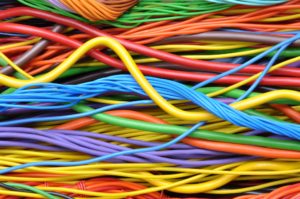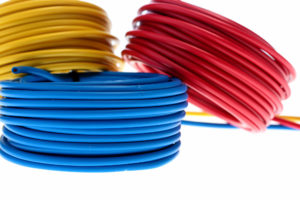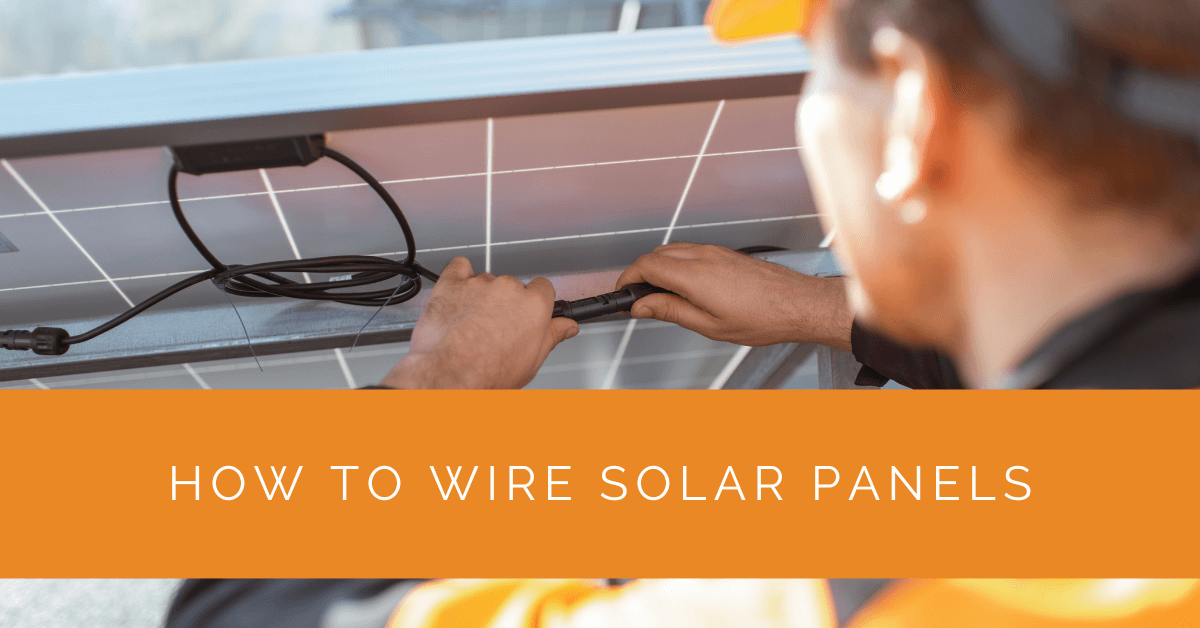Solar panel systems are a reliable and eco-friendly source of energy. Proper wiring is crucial for maximizing their efficiency and output. This comprehensive guide will explore the intricacies of wiring solar panels, whether in series or parallel and provide step-by-step instructions to help you create a robust solar system.
Contents
- 1 Understanding Solar Panel Wiring Basics
- 2 Series Wiring vs. Parallel Wiring: Which is Right for You?
- 3 Choosing Between Series and Parallel Wiring
- 4 Wiring Solar Panels in Series and Parallel: Step-by-Step Guide
- 5 Advanced Techniques: Expanding Your Solar System
- 6 Series and Parallel Combination: Achieving the Best of Both Worlds
- 7 Case Study: Wiring Solar Panels for Optimal Performance
- 8 Expert Insights From Our Solar Panel Installers About Wiring Solar Panels
- 9 Experience Solar Excellence with Us!
- 10 Conclusion
- 11 FAQ
Understanding Solar Panel Wiring Basics
To wire solar panels effectively, it’s essential to grasp the fundamental concepts. Let’s delve deeper into the various components of solar panel wiring and their functions.
- Solar panels: These are the heart of your system, converting sunlight into electricity. We’ll explain how solar panels generate DC (direct current) power and the importance of selecting high-quality panels.
- Inverters: Inverters convert DC power from solar panels into AC (alternating current) power suitable for use in homes or businesses. We’ll explore the different types of inverters, including string and microinverters, and discuss their pros and cons.
- Solar PV systems: Understanding the overall solar PV system is crucial for successful wiring. We’ll explain the components of a solar PV system, such as combiner boxes, charge controllers, and batteries (if applicable), and their roles in the system.
By solidly understanding these basics, you’ll be better equipped to wire your solar panels effectively.
Series Wiring vs. Parallel Wiring: Which is Right for You?
Two primary wiring configurations, series and parallel, offer distinct advantages. Let’s dive deeper into each method to understand their characteristics and determine which suits your specific needs.
Series Wiring
Series wiring involves connecting solar panels one after another to create a string. This configuration increases the overall system voltage. Why would you choose series wiring? Let’s explore its benefits:
- Increased system voltage: Series wiring allows you to combine the voltage outputs of individual panels, resulting in higher system voltage. This can be advantageous when transmitting power over long distances or connecting to grid-tied inverters requiring higher voltage inputs.
- Simplified wiring: Wiring panels in series simplifies the overall system wiring by reducing the number of connections. With fewer connections, the chances of wiring errors and performance issues decrease.
However, it’s also important to consider the limitations of series wiring. Shade or performance issues with one panel can affect the entire string, reducing the overall system output. We’ll discuss how to mitigate these issues later in the guide.
Parallel Wiring
Parallel wiring involves connecting the positive terminals of multiple solar panels and the negative terminals likewise. This configuration allows for increased current capacity. Let’s explore the advantages of parallel wiring:
- Improved performance in shaded areas: Each panel operates independently When wired in parallel. This means that if one-panel experiences shading or a decrease in performance, it won’t affect the entire system. Parallel wiring is particularly beneficial in situations where shading is a concern.
- Flexibility in system design: Parallel wiring offers flexibility regarding system design. You can add or remove panels without significantly impacting the overall system voltage.
While parallel wiring offers advantages, it’s important to consider the increased complexity of wiring multiple panels together and the higher current levels involved.

Choosing Between Series and Parallel Wiring
Now that you have a deeper understanding of series and parallel wiring, it’s time to choose the best configuration for your solar panel system. Several factors will influence your decision:
- System requirements: Determine the specific voltage and current requirements of your system. Consider factors such as the capacity of your inverter, the distance between panels and the inverter, and any voltage limitations imposed by local regulations.
- Available space: Evaluate the physical space available for your solar panels. If space is limited, you may need to consider a wiring configuration that allows for efficient use of space, such as series wiring, which reduces the number of interconnections.
- Shading and performance considerations: Assess the shading conditions in your installation area. If shading is a concern, parallel wiring can help mitigate the impact of shading on overall system performance. On the other hand, if shading is minimal and you prioritize maximizing voltage, series wiring may be more suitable.
- Expansion plans: Consider your future expansion plans for the solar system. If you anticipate adding more panels, parallel wiring offers greater flexibility as you can easily add or remove panels without affecting the system voltage.
- System monitoring and maintenance: Reflect on your monitoring and maintenance preferences. Series wiring allows for monitoring the performance of individual panels within a string, while parallel wiring simplifies troubleshooting and maintenance as panels can be isolated more easily.
Carefully weigh these factors in deciding on the most suitable wiring configuration for your needs. Consulting with a professional solar installer can provide valuable insights tailored to your unique circumstances.
Wiring Solar Panels in Series and Parallel: Step-by-Step Guide
Now that you have determined whether series or parallel wiring is the best choice for your solar panel system, it’s time to dive into the practical aspect of wiring. Let’s explore detailed step-by-step guides for both series and parallel wiring methods.
Wiring Solar Panels in Series
To wire solar panels in series, follow these steps:
- Start by identifying the positive and negative terminals of each solar panel.
- Connect the positive terminal of one panel to the negative terminal of the next panel.
- Continue connecting the panels in a chain until you have connected all the panels in series.
- Ensure secure and proper connections by using appropriate connectors and cables.
- Once the panels are connected in series, connect the positive and negative terminals of the first and last panels to the corresponding terminals of your inverter.
Throughout the process, pay attention to cable sizing, proper grounding, and using the correct connectors. Additionally, adhere to safety guidelines and local electrical codes to ensure a safe and reliable installation.
Wiring Solar Panels in Parallel
To wire solar panels in parallel, follow these steps:
- Identify the positive and negative terminals of each solar panel.
- Connect the positive terminals of all the panels using suitable connectors.
- Similarly, connect the negative terminals of all the panels.
- Ensure secure and proper connections, ensuring cable sizing, grounding, and using appropriate connectors.
- Once the panels are connected in parallel, connect the positive and negative terminals of the parallel configuration to the corresponding terminals of your inverter.
Throughout the process, follow safety precautions, use high-quality cables, connectors, and properly size your wires to ensure optimal performance and safety.

Advanced Techniques: Expanding Your Solar System
Once you’ve mastered series and parallel wiring, you may consider expanding your solar system to meet increased energy needs. Here are advanced techniques to explore:
Series-Parallel Combination
A series-parallel combination allows for both increased system voltage and current capacity. This configuration involves creating multiple strings of panels wired in series and then connecting these strings in parallel. The series-parallel combination can offer the best of both worlds by leveraging the advantages of series and parallel wiring.
String Inverters
String inverters are commonly used in larger solar installations. Instead of connecting each panel individually to an inverter, string inverters enable the connection of multiple panels in a string. This setup simplifies the wiring process and reduces the number of inverters required.
By connecting panels in strings and using a string inverter, you can optimize your solar system’s performance. Here’s an overview of the process:
- Determine the number of panels you want to include in each string. This will depend on the specifications of your string inverter and the total number of panels in your system.
- Connect the positive terminal of the first panel in each string to the positive terminal of the next panel, forming a series connection within each string. Repeat this process for all the strings.
- Connect the negative terminal of the first panel in each string to the negative terminal of the next panel, maintaining the series connection within each string.
- Connect each string’s positive and negative terminals to the corresponding terminals of the string inverter.
- Ensure proper cable sizing, grounding, and secure connections throughout the wiring process.
String inverters provide advantages such as centralized monitoring and efficient power conversion. However, it’s essential to consider the limitations, such as the impact of shading on the overall string performance.
Series and Parallel Combination: Achieving the Best of Both Worlds
In certain situations, a combination of series and parallel wiring may be the ideal solution to optimize your solar panel system. This hybrid configuration allows for increased voltage and current capacity. Here’s how you can achieve the best of both worlds:
- Start by dividing your solar panels into groups. Each group will consist of panels wired in series.
- Wire the panels within each group in series, connecting one panel’s positive terminal to the next’s negative terminal.
- Connect these groups in parallel once you have multiple panels wired in series. Connect the positive terminals of each group and the negative terminals likewise.
- Finally, connect the positive and negative terminals of the series-parallel combination to the corresponding terminals of your inverter.
Combining series and parallel wiring allows you to customize your system to meet specific voltage and current requirements while maintaining flexibility for future expansion.
Case Study: Wiring Solar Panels for Optimal Performance
Background
At Solar Panels Network USA, we were approached by a homeowner looking to install a solar panel system that could effectively handle partial shading and maximize energy output. The homeowner’s property had several trees, creating complex shading patterns throughout the day.
Project Overview
The primary objective was to design and implement a solar panel system that could deliver consistent power despite varying sunlight conditions. This required a strategic approach to wiring, ensuring both high efficiency and reliability.
Implementation
- Assessment and Planning: Our initial step involved a detailed site assessment. We used advanced shading analysis tools to map out the areas of potential shading and determine the best locations for the solar panels. The analysis revealed that certain parts of the roof would experience intermittent shading due to tree branches.
- Series and Parallel Wiring Configuration: Based on our assessment, we decided to employ a hybrid wiring approach. For sections with minimal shading, we used series wiring to boost system voltage and minimize the number of connections. This setup was ideal for transmitting power efficiently over the distance required.
- For areas prone to shading, we opted for parallel wiring. This configuration allowed each panel to operate independently, ensuring that shaded panels wouldn’t drastically reduce the system’s overall performance. By combining these two methods, we achieved a balanced and robust system design.
- Installation Process: We started by installing the solar panels in the predetermined locations, ensuring optimal orientation and tilt angles. The series-wired panels were connected first, followed by the parallel-wired panels. Proper cable management was crucial, so we used high-quality connectors and ensured secure, weatherproof connections.
- Integration with Inverter and Monitoring System: The panels were then connected to a central inverter capable of handling the hybrid wiring setup. We also installed a comprehensive monitoring system, allowing the homeowner to track real-time performance and energy production from each panel group.
Results
The hybrid wiring configuration proved highly effective. The series-wired panels consistently delivered high voltage, while the parallel-wired panels maintained stable performance even when partially shaded. This dual approach optimized energy production throughout the day, regardless of varying sunlight conditions.
Summary
Our strategic use of series and parallel wiring allowed us to create a highly efficient and resilient solar panel system for the homeowner. By addressing shading issues and maximizing energy output, we demonstrated how thoughtful design and implementation could overcome site-specific challenges. This project reinforced the importance of tailored solutions in solar installations, ensuring that each system is optimized for its unique environment.
Expert Insights From Our Solar Panel Installers About Wiring Solar Panels
Proper wiring is the cornerstone of any successful solar installation. Ensuring correct series and parallel connections can maximize efficiency and performance.
Lead Solar Installer
Understanding the difference between series and parallel wiring is crucial. Each method offers unique advantages depending on your specific energy needs and site conditions.
Senior Solar Technician
Safety and compliance with local electrical codes cannot be overstated. Secure connections and proper cable sizing are essential for a reliable solar panel system.
Solar Installation Specialist
Experience Solar Excellence with Us!
Trust in Solar Panels Network USA, where our seasoned experts deliver top-quality solar solutions for homes and businesses nationwide. With a legacy of countless successful installations and a commitment to sustainable energy, we’re your reliable partner in the solar journey. Ready for a brighter, eco-friendly future? Call us now at (855) 427-0058 and harness the power of the sun!
Conclusion
With a solid understanding of solar panel wiring basics and the considerations for series and parallel wiring, you are equipped to create an efficient and high-performing solar panel system. Whether you choose series, parallel, or a combination, follow safety guidelines and local electrical codes and consult with a professional solar installer when needed.
By taking the time to wire your solar panels correctly, you can maximize the potential of your solar power generation, contribute to a sustainable future, and enjoy the benefits of clean, renewable energy.
Unlock the full potential of your solar panels through effective wiring. Start your journey towards a greener future today!
FAQ
What is the best way to wire solar panels?
The best way to wire solar panels depends on various factors, including your specific energy needs, available space, shading conditions, and system requirements. Both series and parallel wiring configurations offer advantages. Series wiring increases voltage, while parallel wiring increases current capacity. Determining the best way to wire your solar panels requires considering these factors and consulting with a professional installer for personalized recommendations.
How do I wire solar panels into my house?
Wiring solar panels into your house involves several steps to ensure a safe and efficient installation. Here’s a general overview:
- Install the solar panels in a suitable location with adequate sunlight exposure.
- Connect the positive and negative terminals of the panels according to your chosen wiring configuration (series, parallel, or combination).
- Route the wiring from the panels to the inverter, ensuring proper cable sizing, grounding, and secure connections.
- Connect the inverter to your house’s electrical system, following local electrical codes and regulations.
- Install a suitable solar panel disconnect switch and a production meter to monitor energy generation.
Hiring a qualified electrician or solar professional to handle the electrical connections and ensure compliance with safety standards and local regulations is crucial.
What are the different ways to wire solar panels?
There are primarily two ways to wire solar panels: series wiring and parallel wiring.
- Series Wiring: In series wiring, the positive terminal of one solar panel is connected to the negative terminal of the next panel, creating a chain-like configuration. This increases the system voltage while maintaining the current.
- Parallel Wiring: Parallel wiring involves connecting the positive terminals of multiple solar panels and the negative terminals likewise. This configuration increases the current capacity while maintaining the system voltage.
You can also employ a combination of series and parallel wiring to achieve specific voltage and current requirements.
Is it better to wire solar panels in series or parallel?
The decision to wire solar panels in series or parallel depends on your specific needs and circumstances. Here’s a comparison:
- Series Wiring: Wiring panels in series increases the overall system voltage. It is advantageous when transmitting power over long distances or connecting to grid-tied inverters requiring higher voltage inputs. However, shading or performance issues with one panel can affect the entire series string, reducing overall system output.
- Parallel Wiring: Parallel wiring allows for increased current capacity. It is beneficial when shading is a concern, as each panel operates independently. Parallel wiring offers flexibility in system design and ease of troubleshooting. However, it requires more complex wiring and careful consideration of wire sizing and connections.
The best approach depends on available space, shading conditions, expansion plans, and system requirements. Consulting with a professional solar installer will help you make an informed decision tailored to your needs.
Remember, the wiring configuration must comply with local electrical codes and safety standards to ensure a safe and efficient solar panel system.
About the Author
Solar Panels Network USA stands at the forefront of solar energy solutions, driven by a team of seasoned solar engineers and energy consultants. With over decades of experience in delivering high-quality solar installations and maintenance, we are committed to promoting sustainable energy through customer-centric, tailored solutions. Our articles reflect this commitment, crafted collaboratively by experts to provide accurate, up-to-date insights into solar technology, ensuring our readers are well-informed and empowered in their solar energy decisions.

